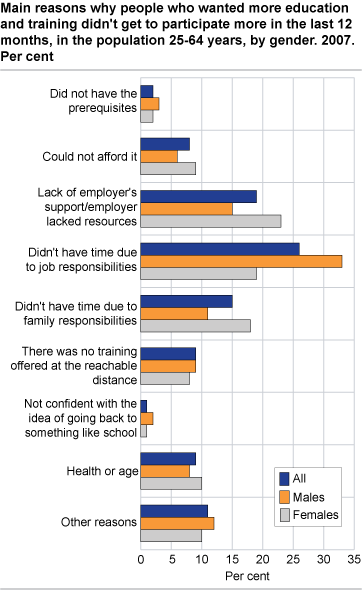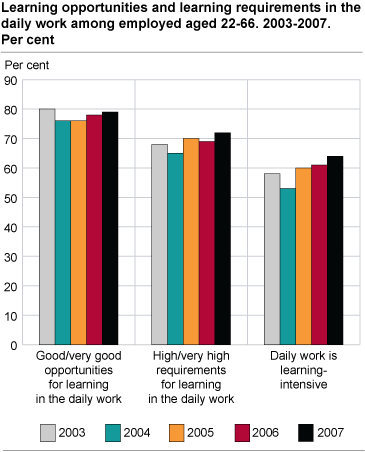Content
Published:
This is an archived release.
Work is the focal point of adult learning
In 2007, more than half of all employed had participated in training during the last twelve months, compared to only a fifth of those who were not employed. However, although employment contributes to learning, a quarter of those who would like more training said that lack of time was a key obstacle.
These are some of the results of the Norwegian part of the European Adult Education Survey (AES) coordinated by Eurostat.
|
The Norwegian AES was conducted from May to August 2007. The reference period for this survey is the twelve months prior to the day of the interview. The Norwegian AES has been designed to meet international AES requirements and ensure the continuation of selected main indicators from a similar national survey; the Learning Conditions Monitor. The Learning Conditions Monitor was conducted as an annual ad hoc module to the Labour Force Survey in the period 2003 to 2006. Education is defined here as formal education. Training/non-formal training refers to all types of organised learning activities that do not lead to a formal qualification. This includes courses, private lessons, conferences etc where learning is the main purpose (cf. About the statistics). |
Workplace key arena for learning
The workplace is an important arena for organised learning and a person’s work is an important motivation factor. Three quarters of all employees took part in all or most of their training during paid working hours. Furthermore, more than 90 per cent of participants in non-formal training stated that all or part of it was job-related.
32 per cent of the job-related non-formal training was provided by the employers themselves, a decrease of 14 percentage points compared to the Learning Conditions Monitor from 2005.
More people have learning-intensive work
There is no doubt that the workplace is a key arena for organised learning. In addition, a person’s day-to-day tasks also lead to the acquisition of new skills and knowledge. Compared to previous Learning Conditions Monitor surveys, the AES indicates that a larger proportion of employed experienced that their daily work both provided them with good opportunities for learning and required the learning of new skills. In 2007, 63 per cent of the employed reported having such learning-intensive work, 5 percentage points more than in 2003. The extent of learning-intensive work varies between groups of employees. Only half of all employed above the age of 60 said that they have learning-intensive work, a level that has been stable since 2003. The level of educational attainment is important for the opportunities and requirements for learning. In 2007, 52 per cent of employees with less than upper secondary education had learning-intensive work, compared to 87 per cent of those with long tertiary education.
Not enough time to take part in education and training
37 per cent of the population would like to take part in more education and training than they had done in the last twelve months. This opinion was more common among those who had participated than among non-participants (47 versus 23 per cent). Although being employed is a positive factor for adult learning, 33 per cent of the men and 19 per cent of the women said that job responsibilities were the main obstacle. Responsibilities at home were another important obstacle for 18 per cent of the women and 11 per cent of the men.
Tables:
- Table 1 Participation in formal education and non-formal training in the last 12 months in the population 25-64 years, by gender, age, level of education and self-defined labour status. Per cent. 2007
- Table 2 Participation in job-related non-formal training in the population 25-64 years, by gender, age and level of education. Per cent. 2007
- Table 3 Participation in non-formal training during paid working hours in the population 25-64 years, by gender, age and educational attainment level. Per cent. 2007
- Table 4 Instruction hours in job related non-formal training among employed aged 22-66, by providers. Per cent. 2003-2007
- Table 5 Learning opportunities and learning requirements in the daily work among employed aged 22-66, by gender, age, level of education and economic activity. Per cent. 2003-2007
- Table 6 The willingness to participate in education and training in the population 25-64 years, by participation in the last 12 months. Per cent. 2007
- Table 7 People stating various main reasons for why they didn't participate (more) in education and training in the last 12 months, as a percentage of the population 25-64 years who wanted to participate (more), by gender, age and economic activity. Per cent. 2007
Contact
-
Anna-Lena Keute
E-mail: anna.keute@ssb.no
tel.: (+47) 95 44 30 88
-
Kjartan Steffensen
E-mail: kjartan.steffensen@ssb.no
tel.: (+47) 90 61 05 17



